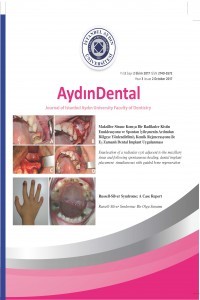PULL-OUT STRENGTH OF FIBER POSTS LUTED WITH DIFFERENT SELF-ADHESIVES
Self-adeziv sistemler, Kök-Kanal Simantasyonu, Post-Kor
PULL-OUT STRENGTH OF FIBER POSTS LUTED WITH DIFFERENT SELF-ADHESIVES
Self-adhesive systems, root-canal cementation, post-core,
___
- Bitter K, Meyer-Lueckel H, Priehn K, Kanjuparambil JP, Neumann K, Kielbassa AM. Effects of luting agent and thermocycling on bond strengths to root canal dentine. Int Endod J. 2006;39:809-18.
- Bergman B, Lundquist P, Sjogren U, Sundquist G. Restorative and endodontic results after treatment with cast posts and cores. J Prosthet Dent. 1989;61:10-5.
- Bitter K, Priehn K, Martus P, Kielbassa AM. In vitro evaluation of push-out bond strengths of various luting agents to tooth- colored posts. J Prosthet Dent. 2006;95:302- 10.
- Fokkinga WA, Kreulen CM, Vallittu PK, Creugers NH. A structured analysis of in vitro failure loads and failure modes of fiber, metal, and ceramic post-and-core systems. Int J Prosthodont. 2004;17:476-82.
- Cormier CJ, Burns DR, Moon P. In vitro comparison of the fracture resistance and failure mode of fiber, ceramic, and conventional post systems at various stages of restoration. J Prosthodont. 2001;10:26- 36.
- Newman MP, Yaman P, Dennison J, Rafter M, Billy E. Fracture resistance of endodontically treated teeth restored with composite posts. J Prosthet Dent. 2003;89:360-7.
- Ohlmann B, Fickenscher F, Dreyhaupt J, Rammelsberg P, Gabbert O, Schmitter M. The effect of two luting agents, pretreatment of the post, and pretreatment of the canal dentin on the retention of fiber-reinforced composite posts. J Dent. 2008;36:87-92.
- Victorino KR, Kuga MC, Duarte MA, Cavenago BC, So MV, Pereira JR. The effects of chlorhexidine and ethanol on push-out bond strength of fiber posts. J Conserv Dent. 2016;19:96-100.
- D’Arcangelo C, Zazzeroni S, D’Amario M, Vadini M, De Angelis F, Trubiani O, et al. Bond strengths of three types of fibre- reinforced post systems in various regions of root canals. Int Endod J. 2008;41:322-8.
- Radovic I, Mazzitelli C, Chieffi N, Ferrari M. Evaluation of the adhesion of fiber posts cemented using different adhesive approaches. Eur J Oral Sci. 2008;116:557- 63.
- Saskalauskaite E, Tam LE, McComb D. Flexural strength, elastic modulus, and pH profile of self-etch resin luting cements. J Prosthodont. 2008;17:262-8.
- Rezende EC, Gomes GM, Szesz AL, Bueno CE, Reis A, Loguercio AD. Effects of Dentin Moisture on Cementation of Fiber Posts to Root Canals. J Adhes Dent. 2016;18:29-34.
- Gerth HU, Dammaschke T, Zuchner H, Schafer E. Chemical analysis and bonding reaction of RelyX Unicem and Bifix composites--a comparative study. Dent Mater. 2006;22:934-41.
- Cury AH, Goracci C, de Lima Navarro MF, Carvalho RM, Sadek FT, Tay FR, et al. Effect of hygroscopic expansion on the push-out resistance of glass ionomer-based cements used for the luting of glass fiber posts. J Endod. 2006;32:537-40.
- Sadek FT, Goracci C, Monticelli F, Grandini S, Cury AH, Tay F, et al. Immediate and 24- hour evaluation of the interfacial strengths of fiber posts. J Endod. 2006;32:1174-7.
- Kremeier K, Fasen L, Klaiber B, Hofmann N. Influence of endodontic post type (glass fiber, quartz fiber or gold) and luting material on push-out bond strength to dentin in vitro. Dent Mater. 2008;24:660-6.
- Bitter K, Paris S, Pfuertner C, Neumann K, Kielbassa AM. Morphological and bond strength evaluation of different resin cements to root dentin. Eur J Oral Sci. 2009;117:326-33.
- Kious AR, Roberts HW, Brackett WW. Film thicknesses of recently introduced luting cements. J Prosthet Dent. 2009;101:189-92.
- Arrais CA, Giannini M, Rueggeberg FA. Kinetic analysis of monomer conversion in auto- and dual-polymerizing modes of commercial resin luting cements. J Prosthet Dent. 2009;101:128-36.
- Al-Assaf K, Chakmakchi M, Palaghias G, Karanika-Kouma A, Eliades G. Interfacial characteristics of adhesive luting resins and composites with dentine. Dent Mater. 2007;23:829-39.
- Gaston BA, West LA, Liewehr FR, Fernandes C, Pashley DH. Evaluation of regional bond strength of resin cement to endodontic surfaces. J Endod. 2001;27:321- 4.
- Muniz L, Mathias P. The influence of sodium hypochlorite and root canal sealers on post retention in different dentin regions. Oper Dent. 2005;30:533-9.
- Yoshiyama M, Matsuo T, Ebisu S, Pashley D. Regional bond strengths of self-etching/ self-priming adhesive systems. J Dent. 1998;26:609-16.
- Bouillaguet S, Troesch S, Wataha JC, Krejci I, Meyer JM, Pashley DH. Microtensile bond strength between adhesive cements and root canal dentin. Dent Mater. 2003;19:199-205.
- Vaz RR, Hipolito VD, D’Alpino PH, Goes MF. Bond strength and interfacial micromorphology of etch-and-rinse and self-adhesive resin cements to dentin. J Prosthodont. 2012;21:101-11.
- D’Arcangelo C, De Angelis F, D’Amario M, Zazzeroni S, Ciampoli C, Caputi S. The influence of luting systems on the microtensile bond strength of dentin to indirect resin-based composite and ceramic restorations. Oper Dent. 2009;34:328-36.
- ISSN: 2149-5572
- Yayın Aralığı: Yılda 3 Sayı
- Başlangıç: 2015
- Yayıncı: İstanbul Aydın Üniversitesi
MUTAGENIC POTENTIAL OF A SELF-ADHESIVE FLOWABLE COMPOSITE
Tuğba TOZ, Zeliha AYDOĞAN, Duygu TUNCER, Emel KARAMAN
NANOCERAMICS AND HYBRID MATERIALS USED IN CAD/CAM SYSTEMS
Nesrin CEREN, Volkan TURP, Faruk EMİR, Gökhan AKGÜNGÖR, Simel AYYILDIZ, Deniz ŞEN
ENDODONTIC TREATMENT OF MANDIBULAR PREMOLAR WITH THREE CANALS USING CBCT
Seda AYDEMİR, Alper SİNANOĞLU, İşıl Kaya BÜYÜKBAYRAM, Göze ARUKASLAN
SINGLE NO-PREP PORCELAIN LAMINATE VENEER RESTORATIONS; 2 CASE REPORTS
Volkan TURP, Simel AYYILDIZ, Deniz ŞEN, Gülcan BAHARDIRLI
CHAIRSIDE CEREC SYSTEM AND CAD/CAM MATERIALS
İşıl Kaya BÜYÜKBAYRAM, Engin Fırat ÇAKAN, Mağrur KAZAK
PULL-OUT STRENGTH OF FIBER POSTS LUTED WITH DIFFERENT SELF-ADHESIVES
Engin Fırat ÇAKAN, Fatma YILDIRIM, Ahu TOPKARA
PROLIFERATIVE VERRUCOUS LEUKOPLAKIA: FIVE YEARS FOLLOW-UP
Behçet EROL, Sercan KÜÇÜKKURT, Tuğçe Biçer AYTUGAR, Nihan AKSAKALLI
